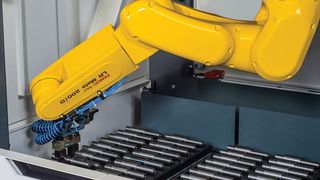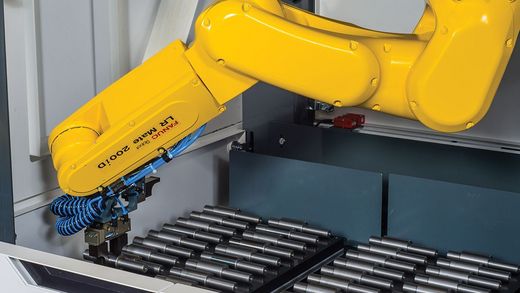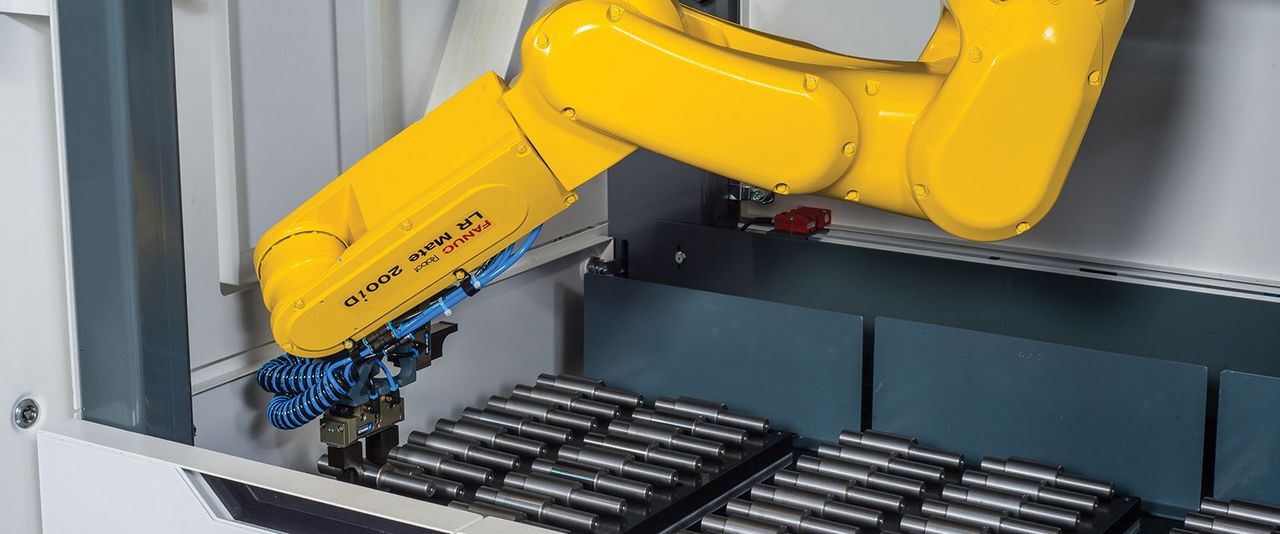5 Ways an Automated Grinding Machine Can Deliver ROI
Whether you are considering an automated grinding machine to address a pain point in shop operations, have concerns about replacing an aging workforce, or need to lower cost per part to retain clients and stay ahead of the competition, the value of automation will become quickly apparent.
According to calculations based on data from the Robotics Industries Association (RIA), installing a $150,000 UNITED GRINDING flexLoad system and associated tooling for two shifts a day for five days a week instead of an operator will save more than $1.5 million in labor costs over 15 years. It can pay for itself in about 18 months. You can run your numbers through the RIA’s Robot System Value Calculator using variables specific to your situation to see your potential ROI.
Grinding automation delivers many direct and indirect benefits. Here are five specific ways an automated grinding machine can deliver ROI.
1. Labor: Reduce Cost on Many Repetitive, Production Tasks
Many small- and medium-sized manufacturers tend to undervalue the cost of employment and overvalue the cost of equipment because of the high up-front cost. But the math pencils out, especially given the difficulty many grinding manufacturers face in replacing an aging workforce.
The cost of a $15 per hour operator with benefits may be about $21 per hour. Amortizing the cost of financing and operating a $250,000 CNC grinder over a 15-year life span could be as low as $3 per hour, according to Production Machining.
Robots also handle repetitive and often unsafe manual tasks without the possibility of mental fatigue — such as loading and unloading, gauging, and deburring.
2. Human Capital: Put Your People in More Impactful Positions
Deloitte projects that by 2025 about 2 million manufacturing jobs will go unfilled due to the widening skills gap. Automation helps mitigate that risk by extending the skills of the existing labor force.
For example, a STUDER ID or OD grinding machine equipped with our flexLoad robot performs over 90 percent of the necessary labor per shift. That means operators can oversee multiple machines in the production cell, creating additional value. Other less tangible benefits include:
- Production planning becomes based on unique batch needs as opposed to how many people you have available to load a machine. For example, extra-care batches may be run during the day and more automated processes on second or third shifts.
- Job roles and responsibilities in robotics are more attractive to what technology-mind young people prefer. They often can see themselves growing with the evolving 4.0 industry.
3. Enhanced Productivity: Repeatable Precision Has Many Impacts
The secret to automation efficiency is not so much speed as it is continuity and consistent quality. The repeatable precision results in better quality, reduced errors and increased uptime. This ultimately lowers the price per part.
Numerous innovations in vision systems, barcoding and end-of-arm robot tooling, along with automatic tool and wheel changing, now play a large role in the optimization of HMLV automated processes. With effective management of grippers, trays, and pallets, for example, changeover times can be drastically reduced.
4. Application Efficiency: Interfaces Integrate With Many Components
Grinding automation begins with process optimization and prevents scope creep by providing a standardized yet versatile and expandable platform.
Many STUDER and other UNITED GRINDING machines are sold with built-in automation interfaces for a flexLoad system, gantry robots, palletized part loading solutions, gauging systems and more to support this sort of standardization in the face of varied needs.
Other application efficiencies can be realized with barcoding, washing, demag, deburr, measuring, laser making, re-grip, and more.
And finally, other ROI drivers include material savings from less scrap and integration with ERP, SCM and MES software.
5. Facility Utilization: Energy Efficiency, Smaller Footprints
Automation systems generate less energy than the older machines they replace with “little wasted heat, using the minimum power, and focusing on controlled and precise movements,” according to the Association for Advancing Automation.
Other energy savings can be realized from less idling time and lower heating and lighting costs during unattended production.
Automation also helps accommodate present thinking regarding shop floor-space utilization through loader systems with small footprints, overhead gantry style loaders and fenceless systems.
The Many Benefits of an Automated Grinding Machine When It Comes to ROI
The many benefits of grinding automation add up to a significant ROI. In our study mentioned above, UNITED GRINDING found that one flexLoad system running two shifts a day for five days a week improved productivity 33 percent per shift over an operator working alone.
Based on this data and the growing literature on automation’s benefits for manufacturing, shops that can leverage automated grinding machines, whether for a full production process or allowing a machine to run unattended for several hours, will be more competitive and efficient regardless of size or industry.
Choose the right partner to ensure you end up with the right solution, a smooth installation, proper training and a trusted service provider. UNITED GRINDING North America is an RIA member and a FANUC authorized systems integrator.
Learn more about UNITED GRINDING’s Automation Solutions and give us a chance to prove to you how we can help you realize near-term and long-term ROI with an automated grinding machine.









